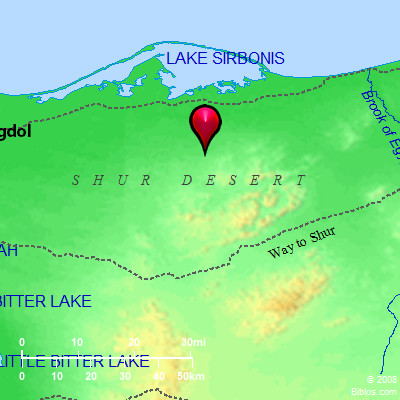Atlas  Shur Desert and surrounding area Maps Created using Biblemapper 3.0 Additional data from OpenBible.info Occurrences Genesis 16:7 The angel of Yahweh found her by a fountain of water in the wilderness, by the fountain in the way to Shur.Genesis 20:1 Abraham traveled from there toward the land of the South, and lived between Kadesh and Shur. He lived as a foreigner in Gerar. Genesis 25:18 They lived from Havilah to Shur that is before Egypt, as you go toward Assyria. He lived opposite all his relatives. Exodus 15:22 Moses led Israel onward from the Red Sea, and they went out into the wilderness of Shur; and they went three days in the wilderness, and found no water. 1 Samuel 15:7 Saul struck the Amalekites, from Havilah as you go to Shur, that is before Egypt. 1 Samuel 27:8 David and his men went up, and made a raid on the Geshurites, and the Girzites, and the Amalekites; for those nations were the inhabitants of the land, who were of old, as you go to Shur, even to the land of Egypt. Encyclopedia SHURshur, shoor (shur; Sour): The name of a desert East of the Gulf of Suez. The word means a "wall," and may probably refer to the mountain wall of the Tih plateau as visible from the shore plains. In Genesis 16:7 Hagar at Kadesh (`Ain Qadis) (see 16:14) is said to have been "in the way to Shur." Abraham also lived "between Kadesh and Shur" (Genesis 20:1). The position of Shur is defined (Genesis 25:18) as being "opposite Egypt on the way to Assyria." After crossing the Red Sea (Exodus 15:4) the Hebrews entered the desert of Shur (Exodus 15:22), which extended southward a distance of three days' journey. It is again noticed (1 Samuel 15:7) as being opposite Egypt, and (1 Samuel 27:8) as near Egypt. There is thus no doubt of its situation, on the East of the Red Sea, and of the Bitter Lakes. |



